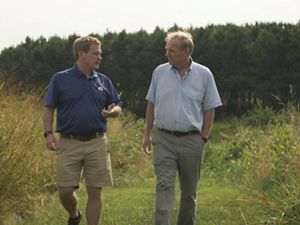The Great Plains of North America is a largely agricultural region. From breadbasket to sustainable beef, the food grown here relies on healthy land and water. The Nature Conservancy and USDA Natural Resources Conservation Service (NRCS) work together across five Great Plains states—Kansas, Missouri, Nebraska, Oklahoma and South Dakota—to help farmers and ranchers improve the health of their soil and make cattle grazing more sustainable. The two organizations are working together to get key conservation programs that are funded through the Farm Bill directly on the ground.
Kansas
NRCS programs are used by Kansas farmers and ranchers in places like the Flint Hills, where conservation easements protect some of the last tallgrass prairie in the world, and in western Kansas, where land enrolled in the Conservation Reserve Program provides critical nesting habitat for grassland birds.

Missouri
In Missouri, NRCS and TNC have partnered on projects through the Regional Conservation Partnership Program. At TNC’s Little Creek Farm, the support of the NRCS Conservation Innovation Grant has helped connect sustainable agriculture practices with local landowners through farm and field days and other outreach efforts. NRCS and TNC also collaborate through the Missouri 4R Initiative, a program to improve soil health and limit the amount of harmful runoff in rivers and streams.

Nebraska
In Nebraska, TNC works with the NRCS on key programs in places like the Sandhills, where ranchers use fire to keep globally significant, intact grasslands healthy and full of wildlife, and the Central Platte River, where farmers are now enrolling in a recently-launched soil health program.

Oklahoma
NRCS and TNC teamed up to increase pollinator habitat on producer lands through the Okies for Monarchs outreach program. The two organizations also work together to protect grazing lands in the Red Hills with conservation easements.

South Dakota
With funding from NRCS, South Dakota State University, South Dakota Corn Growers Association and TNC are developing a roadmap for optimal implementation of conservation practices to reduce risk of drought and flooding. NRCS and TNC also work together to help landowners improve the health and resilience of prairie streams on private land in western South Dakota.





